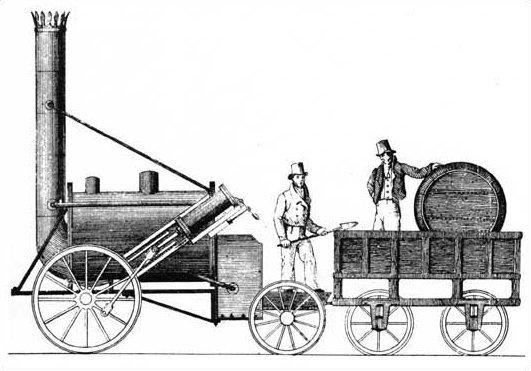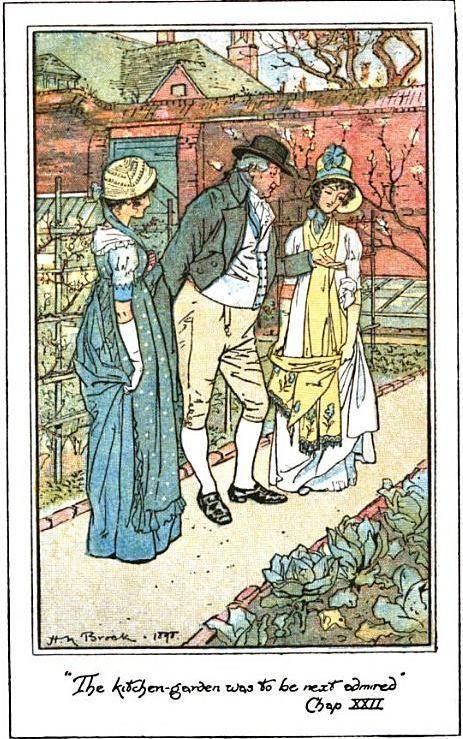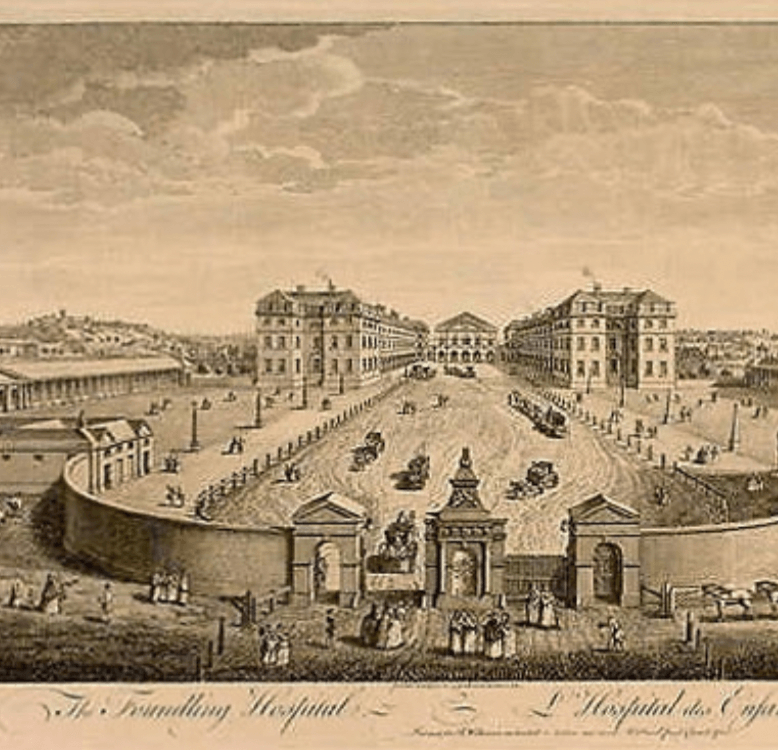
Georgian Era Iron Horses: The Advent of the Steam Locomotive
The Kennet and Avon canal system (built between 1794-1810) winds its picturesque way through Bath and would, no doubt, have been an object of interest to Jane Austen, as it was built during her time there. Intended to connect these two great rivers with the open sea, it was built to provide rapid transportation between Bristol, Bath, and eventually, London.
 Proposed as early as the 17th century, it was built just a little too late and was outdated almost before it was instituted. The opening of the Great Western Railroad in 1841 effectively connected these large cities in a faster, more economical way than could be had by boat. The age of steam (as well as the rest of the Industrial Revolution) was well on its way. Experiments in steam powered locomotion were begun as early as the 1780's, though in fact, the earliest railways employed horses to draw carts along railway tracks. As the development of steam engines progressed through the 18th century, various attempts were made to apply them to road and railway use. In 1784, William Murdoch, a Scottish inventor, built a prototype steam road locomotive. An early working model of a steam rail locomotive was designed and constructed by steamboat pioneer John Fitch in the US probably during the 1780s or 1790s. His steam locomotive used interior bladed wheels guided by rails or tracks. The model still exists at the Ohio Historical Society Museum in Columbus.
Proposed as early as the 17th century, it was built just a little too late and was outdated almost before it was instituted. The opening of the Great Western Railroad in 1841 effectively connected these large cities in a faster, more economical way than could be had by boat. The age of steam (as well as the rest of the Industrial Revolution) was well on its way. Experiments in steam powered locomotion were begun as early as the 1780's, though in fact, the earliest railways employed horses to draw carts along railway tracks. As the development of steam engines progressed through the 18th century, various attempts were made to apply them to road and railway use. In 1784, William Murdoch, a Scottish inventor, built a prototype steam road locomotive. An early working model of a steam rail locomotive was designed and constructed by steamboat pioneer John Fitch in the US probably during the 1780s or 1790s. His steam locomotive used interior bladed wheels guided by rails or tracks. The model still exists at the Ohio Historical Society Museum in Columbus.
 The first full-scale working railway steam locomotive was built by Richard Trevithick in the United Kingdom and, on 21 February 1804, the world's first railway journey took place as Trevithick's unnamed steam locomotive hauled a train along the tramway from the Pen-y-darren ironworks, near Merthyr Tydfil to Abercynon in South Wales.Accompanied with Andrew Vivian, it ran with mixed success.The design incorporated a number of important innovations that included using high-pressure steam which reduced the weight of the engine and increased its efficiency. Trevithick visited the Newcastle area in 1804 and he had a ready audience of colliery owners and engineers. The visit was so successful that the colliery railways in north-east England became the leading centre for experimentation and development of the steam locomotive.Trevithick continued his own steam propulsion experiments through another trio of locomotives, concluding with the Catch Me Who Can in 1808. Four years later, the successful twin-cylinder locomotive Salamanca by Matthew Murray for the edge railed rack and pinion Middleton Railway debuted in 1812.
The first full-scale working railway steam locomotive was built by Richard Trevithick in the United Kingdom and, on 21 February 1804, the world's first railway journey took place as Trevithick's unnamed steam locomotive hauled a train along the tramway from the Pen-y-darren ironworks, near Merthyr Tydfil to Abercynon in South Wales.Accompanied with Andrew Vivian, it ran with mixed success.The design incorporated a number of important innovations that included using high-pressure steam which reduced the weight of the engine and increased its efficiency. Trevithick visited the Newcastle area in 1804 and he had a ready audience of colliery owners and engineers. The visit was so successful that the colliery railways in north-east England became the leading centre for experimentation and development of the steam locomotive.Trevithick continued his own steam propulsion experiments through another trio of locomotives, concluding with the Catch Me Who Can in 1808. Four years later, the successful twin-cylinder locomotive Salamanca by Matthew Murray for the edge railed rack and pinion Middleton Railway debuted in 1812.
 In 1825 George Stephenson built the Locomotion for the Stockton and Darlington Railway, north-east England, which was the first public steam railway in the world. In 1829, he built The Rocket which was entered in and won the Rainhill Trials. This success led to Stephenson establishing his company as the pre-eminent builder of steam locomotives used on railways in the UK, US and much of Europe. The Liverpool and Manchester Railway opened a year later making exclusive use of steam power for passenger and goods trains.
In 1825 George Stephenson built the Locomotion for the Stockton and Darlington Railway, north-east England, which was the first public steam railway in the world. In 1829, he built The Rocket which was entered in and won the Rainhill Trials. This success led to Stephenson establishing his company as the pre-eminent builder of steam locomotives used on railways in the UK, US and much of Europe. The Liverpool and Manchester Railway opened a year later making exclusive use of steam power for passenger and goods trains.  The US started developing steam locomotives in 1829 with the Baltimore and Ohio Railroad's Tom Thumb. This was the first locomotive to run in America, although it was intended as a demonstration of the potential of steam traction, rather than as a revenue-earning locomotive. Many of the earliest locomotives for American railroads were imported from Great Britain, including the Stourbridge Lion and the John Bull (still the oldest operable engine-powered vehicle in the United States of any kind, as of 1981) but a domestic locomotive manufacturing industry was quickly established, with locomotives like the DeWitt Clinton being built in the 1830s. The first railway service in Continental Europe (or for that matter, anywhere outside the UK and the US) was opened on 5 May 1835 in Belgium, between Mechelen and Brussels. The name of the locomotive used was The Elephant.
The US started developing steam locomotives in 1829 with the Baltimore and Ohio Railroad's Tom Thumb. This was the first locomotive to run in America, although it was intended as a demonstration of the potential of steam traction, rather than as a revenue-earning locomotive. Many of the earliest locomotives for American railroads were imported from Great Britain, including the Stourbridge Lion and the John Bull (still the oldest operable engine-powered vehicle in the United States of any kind, as of 1981) but a domestic locomotive manufacturing industry was quickly established, with locomotives like the DeWitt Clinton being built in the 1830s. The first railway service in Continental Europe (or for that matter, anywhere outside the UK and the US) was opened on 5 May 1835 in Belgium, between Mechelen and Brussels. The name of the locomotive used was The Elephant.
In Germany the first working steam locomotive was a rack-and-pinion engine, similar to the Salamanca, designed by the British locomotive pioneer John Blenkinsop. Built in June 1816 by Johann Friedrich Krigar in the Royal Berlin Iron Foundry (Königlichen Eisengießerei zu Berlin), the locomotive ran on a circular track in the factory yard. It was the first locomotive to be built on the European mainland and the first steam-powered passenger service, because curious onlookers could ride in the attached coaches for a fee. It is portrayed on a New Year's badge for the Royal Foundry dated 1816. Another locomotive was built using the same system in 1817. They were to be used on pit railways in Königshütte and in Luisenthal on the Saar (today part of Völklingen), but neither could be returned to working order after being dismantled, moved and reassembled. On 7 December 1835 the Adler ran for the first time between Nuremberg and Fürth on the Bavarian Ludwig Railway. It was the 118th engine from the locomotive works of Robert Stephenson and stood under patent protection.
In 1837 the first steam railway started in Austria on the Emperor Ferdinand Northern Railway between Vienna-Floridsdorf and Deutsch-Wagram. The oldest continually working steam engine in the world also runs in Austria: the GKB 671 built in 1860, has never been taken out of service, and is still used for special excursions. In 1838 the third steam locomotive to be built in Germany, the Saxonia, was manufactured by the Maschinenbaufirma Übigau near Dresden, built by Prof. Johann Andreas Schubert. The first independently designed locomotive in Germany was the Beuth built by August Borsig in 1841. In 1848 the first locomotive produced by Henschel-Werke in Kassel, the Drache, was delivered. The first railway line over Swiss territory was the Strasbourg–Basle line opened in 1844. Three years later, in 1847, the first fully Swiss railway line, the Spanisch Brötli Bahn, from Zürich to Baden was opened.
By the mid-19th century, rail travel was established as the premier transport over land, and, in spite of the opportunities afforded by air and car, it remains a popular way to travel throughout Europe. Modern innovations have created super trains that travel hundreds of miles an hour, however, a longing for the past remains. Several heritage railways in the UK have built new steam locomotives in the 1990s and early 21st century. These include the narrow gauge Ffestiniog and Corris railways in Wales. The Hunslet Engine Company was revived in 2005 and is now building steam locomotives on a commercial basis.A standard gauge LNER Peppercorn Pacific "Tornado" was completed at Hopetown Works, Darlington, England and made its first run on 1 August 2008.It entered main line service later in 2008, to great public acclaim.
Enjoyed this article? If you don't want to miss a beat when it comes to Jane Austen, make sure you are signed up to the Jane Austen newsletter for exclusive updates and discounts from our Online Gift Shop.




1 comment
Thanks so much for the informative post. My newest Regency mystery, The Doppelganger’s Dance, begins with a visit to Leeds to see Murray and Blenkinsop’s locomotive, and I really thought I would be surprising most readers — I know I was surprised to discover that a working model was running during Jane Austen’s time. But if my locomotive will no longer be a surprise, at least people won’t think I’ve gone totally daft; or at least not the people who’ve read your article!
LibiAstaire
Leave a comment
This site is protected by reCAPTCHA and the Google Privacy Policy and Terms of Service apply.